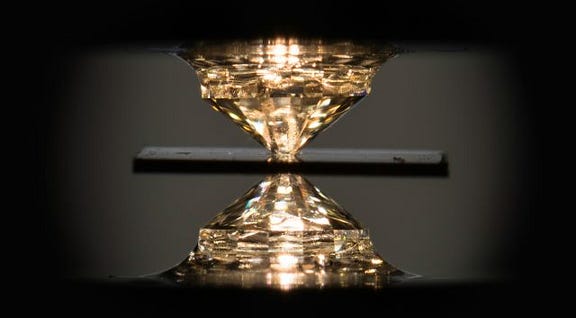by Joel Hruska

The search for a truly room-temperature superconducting material has been one of the great Holy Grails in engineering and physics. The ability to move electricity from Point A to B with zero resistance and hence no losses would be a game-changer for human civilization. Unfortunately, until today, every known superconductor still required very cold temperatures. Today, scientists announced they’ve achieved superconducting at 59 degrees Fahrenheit/15 Celsius. While this is still a bit chilly, you can hit 59F in a well air-conditioned building. This is a genuine breakthrough, but it doesn’t immediately clear the path towards easy deployment of the technology.
At extremely low temperatures, the behavior of electrons through a material changes. At temperatures approaching absolute zero, electrons passing through a material form what are known as Cooper pairs. Normally, single electrons essentially ping-pong through the ionic lattice of the material they are passing through. Each time an electron collides with an ion in the lattice, it loses a tiny amount of energy. This loss is what we call resistance. When cooled to a low enough temperature, electrons behave dramatically differently. Cooper pairs behave like a superfluid, meaning they can flow through material without any underlying energy loss. Tests have demonstrated that current stored inside a superconductor will remain there for as long as the material remains in a superconductive state with zero loss of energy.
There are two problems yet standing between us and a more effective exploitation of this discovery. First, we aren’t sure exactly why this combination of elements works in the first place. The research team used sulfur and carbon, then added hydrogen, forming hydrogen sulfide(H 2S) and methane (CH 4). These chemicals were placed on a diamond anvil and compressed, then exposed to a green laser for several hours to break sulfur-sulfur bonds. This much is known. Unfortunately, determining the exact composition of the material has proven impossible thus far. The diamond anvil prevents the use of X-rays, and existing technologies that can work around that problem aren’t capable of locating hydrogen atoms in a lattice. The team’s efforts to characterize and understand its own discovery are still ongoing.

If this discovery were added to this chart, it would be sitting at the 288K mark. Image by PJRay, from Wikipedia, CC BY-SA 4.0
The researchers also have a second pressing problem: It takes about 2.5M atmospheres of pressure to create the superconducting effect. That’s roughly 75 percent of the pressure found at the Earth’s core, and it’s a bit difficult to replicate on planet Earth. If we were on Jupiter, we’d have a lot fewer problems with duplicating this kind of pressure, but that’s mostly because we’d all be dead and would have a lot fewer problems, period.
The importance of this work is that it proves room-temperature superconductors actually exist. This new material runs 50 degrees Fahrenheit warmer than any previously-known superconductor, which would make it an impressive step forward even if we were still working with sub-zero supercooled temperatures. While the amount of pressure required to reach this operating state makes practical deployment impossible, we now have one known-good method of solving this problem. Where there is one, there could be more.
This discovery doesn’t solve the problem, but it’s a fundamental and necessary part of the puzzle.
No comments:
Post a Comment